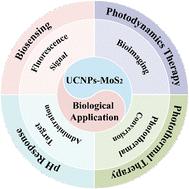当前位置:
X-MOL 学术
›
J. Mater. Chem. B
›
论文详情
Our official English website, www.x-mol.net, welcomes your feedback! (Note: you will need to create a separate account there.)
Recent progress of UCNPs–MoS2 nanocomposites as a platform for biological applications
Journal of Materials Chemistry B ( IF 7 ) Pub Date : 2024-04-24 , DOI: 10.1039/d3tb02958a Yue Wang 1 , Yiru Wang 1 , Huimei Zhong 1 , Lihao Xiong 1 , Jiayi Song 1 , Xinyu Zhang 1 , Ting He 1 , Xiayu Zhou 1 , Le Li 1 , Deshuai Zhen 1
Journal of Materials Chemistry B ( IF 7 ) Pub Date : 2024-04-24 , DOI: 10.1039/d3tb02958a Yue Wang 1 , Yiru Wang 1 , Huimei Zhong 1 , Lihao Xiong 1 , Jiayi Song 1 , Xinyu Zhang 1 , Ting He 1 , Xiayu Zhou 1 , Le Li 1 , Deshuai Zhen 1
Affiliation

|
Composite materials can take advantages of the functional benefits of multiple pure nanomaterials to a greater degree than single nanomaterials alone. The UCNPs–MoS2 composite is a nano-application platform that combines upconversion luminescence and photothermal properties. Upconversion nanoparticles (UCNPs) are inorganic nanomaterials with long-wavelength excitation and short-wavelength tunable emission capabilities, and are able to effectively convert near-infrared (NIR) light into visible light for increased photostability. However, UCNPs have a low capacity for absorbing visible light, whereas MoS2 shows better absorption in the ultraviolet and visible regions. By integrating the benefits of UCNPs and MoS2, UCNPs–MoS2 nanocomposites can convert NIR light with a higher depth of detection into visible light for application with MoS2 through fluorescence resonance energy transfer (FRET), which compensates for the issues of MoS2's low tissue penetration light-absorbing wavelengths and expands its potential biological applications. Therefore, starting from the construction of UCNPs–MoS2 nanoplatforms, herein, we review the research progress in biological applications, including biosensing, phototherapy, bioimaging, and targeted drug delivery. Additionally, the current challenges and future development trends of UCNPs–MoS2 nanocomposites for biological applications are also discussed.
中文翻译:

UCNPs-MoS2纳米复合材料作为生物应用平台的最新进展
与单独使用单一纳米材料相比,复合材料可以更大程度地利用多种纯纳米材料的功能优势。 UCNPs-MoS 2复合材料是一个结合了上转换发光和光热特性的纳米应用平台。上转换纳米颗粒(UCNP)是具有长波长激发和短波长可调发射能力的无机纳米材料,能够有效地将近红外(NIR)光转换为可见光以提高光稳定性。然而,UCNPs吸收可见光的能力较低,而MoS 2在紫外和可见光区域表现出更好的吸收。通过整合UCNPs和MoS 2的优点,UCNPs–MoS 2纳米复合材料可以将具有更高检测深度的近红外光转换为可见光,通过荧光共振能量转移(FRET)与MoS 2一起应用,从而弥补了MoS 2的问题的低组织渗透光吸收波长并扩展了其潜在的生物应用。因此,本文从UCNPs–MoS 2纳米平台的构建入手,综述了生物传感、光疗、生物成像和靶向药物递送等生物应用的研究进展。此外,还讨论了用于生物应用的UCNPs-MoS 2纳米复合材料当前的挑战和未来的发展趋势。
更新日期:2024-04-24
中文翻译:

UCNPs-MoS2纳米复合材料作为生物应用平台的最新进展
与单独使用单一纳米材料相比,复合材料可以更大程度地利用多种纯纳米材料的功能优势。 UCNPs-MoS 2复合材料是一个结合了上转换发光和光热特性的纳米应用平台。上转换纳米颗粒(UCNP)是具有长波长激发和短波长可调发射能力的无机纳米材料,能够有效地将近红外(NIR)光转换为可见光以提高光稳定性。然而,UCNPs吸收可见光的能力较低,而MoS 2在紫外和可见光区域表现出更好的吸收。通过整合UCNPs和MoS 2的优点,UCNPs–MoS 2纳米复合材料可以将具有更高检测深度的近红外光转换为可见光,通过荧光共振能量转移(FRET)与MoS 2一起应用,从而弥补了MoS 2的问题的低组织渗透光吸收波长并扩展了其潜在的生物应用。因此,本文从UCNPs–MoS 2纳米平台的构建入手,综述了生物传感、光疗、生物成像和靶向药物递送等生物应用的研究进展。此外,还讨论了用于生物应用的UCNPs-MoS 2纳米复合材料当前的挑战和未来的发展趋势。






























 京公网安备 11010802027423号
京公网安备 11010802027423号